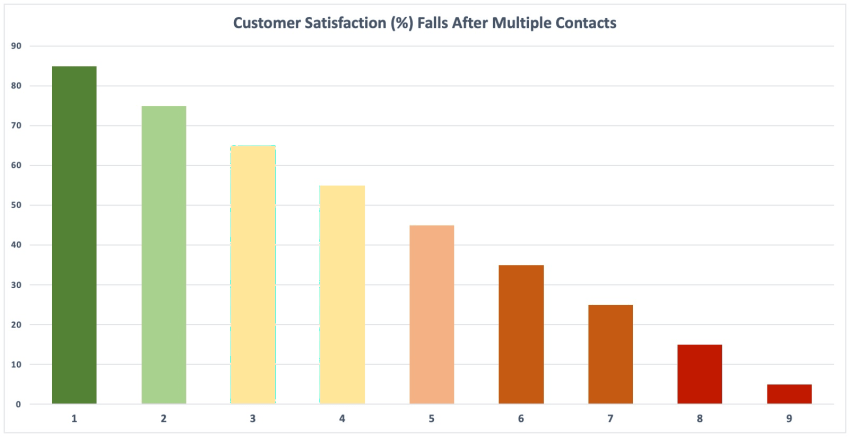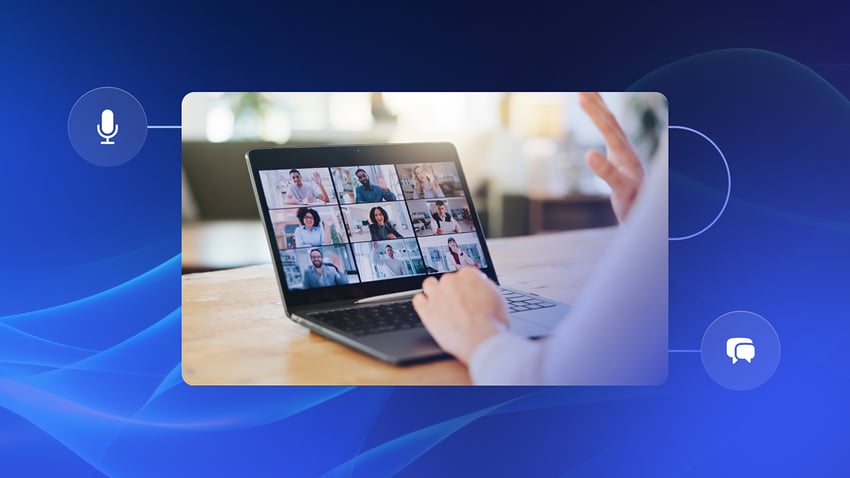No customer wants to be left waiting on hold or bounced between multiple agents when they call with an issue.
They expect quick, seamless service from start to finish. As a business, meeting this expectation is critical for boosting customer satisfaction.
One of the most effective tools for managing calls effectively is an automatic call distribution (ACD) system. This sophisticated business phone system feature routes each incoming call to the right agent, providing callers with a smooth, efficient experience.
In this article, we’ll explore how an ACD system works to enhance call center operations. You’ll learn how intelligent call routing and automatic processes help companies deliver exceptional service. We’ll also discuss key benefits of ACD, from reducing hold times to improving agent collaboration.
What Is Automatic Call Distribution (ACD)?
ACD, or automatic call distribution, is a technology used in contact centers to route incoming calls to available agents based on predetermined rules.
You can distribute calls based on caller ID, business hours, support level, and IVR selections. As a result, inbound calls reach the right agent or department quickly and without the caller having to dial a different phone number.
Imagine a customer calling about a specific appliance at a big-box store. ACD can identify keywords and route the call to an agent familiar with that product line, ensuring expert assistance on the first try.

Automatic call distributors prevent unnecessary transfers by getting inbound calls to the appropriate agent with skill-based routing or other distribution methods. And since it reaches the right agent, handle times remain low with improved customer satisfaction.
What Is the Difference Between IVR and ACD?
An automatic call distributor and interactive voice response (IVR) system are related but distinct technologies that together enable efficient call routing and handling. Understanding how they complement one another is important.
An IVR system handles the initial incoming call by presenting the caller with an IVR menu and options via pre-recorded audio prompts. For example:
“Thank you for calling ABC Company. To speak with sales, press 1. For customer service, press 2. For billing questions, press 3.”
Once the caller selects an option by pressing a number on their phone keypad, the IVR system classifies the type of inquiry and passes the call context to the ACD system.
The ACD then uses intelligent call routing algorithms to direct the call to the best-suited available agent. IVR handles initial call classification while the ACD handles optimal routing and agent assignment.
Together, they facilitate quick, streamlined call resolution using context and logic instead of luck and guesswork.
How Does ACD Work?
An automatic call distribution system optimizes call routing using a multi-step process:
1. Classifies incoming calls
The ACD first uses data from the IVR system or dialed number to classify each call by type and purpose. Customer service calls are flagged differently than billing inquiries, for example.
2. Evaluates agent availability
Next, the ACD system checks the status of call center agents to determine availability to handle additional calls. The system determines the order of the call queues based on factors like:
- Agent availability (also known as CTI status)
- Caller wait time
- Agent skills
- Customer data from a CRM integration
- Number of calls already assigned to an agent
- Time spent on prior calls
- Scheduled breaks or shift changes

3. Assigns call priority
With call type and agent status clarified, the ACD can assign a priority level to each call. VIP customers and high-revenue accounts may be placed higher in the queue.
4. Routes call to the best-fit agent
Agent skills play a key role here. The ACD automatically connects the call to an available agent with the appropriate skills and capacity to handle that specific call type.
5. Offers callback option if needed
If no suitable agents are available, the system places the caller on hold and may offer a callback option to preserve their place in the queue. Agents can then make an outbound callback.
6. Call monitoring and agent performance
Finally, built-in reporting is provided through computer telephony integration (CTI) with insights like average handle time, wait times, abandon rates, and other metrics to refine the routing strategy.
Optimizing these steps enables more efficient assignment of calls to available agents. This gets customers’ answers faster while providing managers with better oversight of operational performance.
The end result is higher customer satisfaction through reduced wait times and better first-call resolution.
Related: Call Center Metrics: 24+ KPIs and Tips To Track Performance
6 Types of ACD Distribution Methods
The best ACD routing option for your business depends on three things:
- What your call center software provider is capable of
- Which customer experience is most important for your business
- The number of available agents and possibly the time of day
There are six key ACD distribution methods to choose from.
1) Round-robin
Round-robin call routing is the simplest way to distribute phone calls. Inbound customer calls are distributed in a fixed queue within your team.
Example: If five agents are available, the first incoming call will go to the first agent. After they accept that call, the next one goes to the second agent. Finally, after the fifth agent is busy, the first agent receives a call, and the process starts again.
2) Talk time-based
Talk time-based call distribution aims to ensure that agents talk to callers for the same amount of time of day, so no one agent is taking on more calls than the others. It works similarly in practice to round-robin distribution.
Example: When a call comes in, it will be routed to the agent with the least handle time. When the next call comes in, the same process repeats, and so on.
3) Fixed order
Fixed order call distribution, sometimes called regular ACD routing, needs a specified order to be determined. That is, calls will be connected to specific agents in the order that you specify.
Example: The policy always insists on routing in hierarchical order if three agents are assigned to the call center. If agents one and two are unavailable, customer calls will be directed to the third agent.
4) Uniform
Uniform call routing sends the inbound call to the agent that has been available the longest. Once they accept a call, they return to the queue until they have the longest available time again. This makes the call volume fairer among staffers, especially for those with a low average handle time.
Example: If you have five agents on your team and agent one took a call seven minutes ago, and agent two received a call 16 minutes ago, the next incoming call will be directed to agent two.

5) Simultaneous
Simultaneous call distribution rings all the available agents’ phones ring simultaneously, thus shortening the call queue. Routing calls this way is ideal when speed is essential to your business. In addition, this minimizes the odds that calls will go to voicemail.
Example: If you have three members of a call group, all of their phones will ring when a new call comes in. The one who answers it first takes the call.
6) Weighted
A weighted call routing plan lets managers set a portion of calls to be routed to specific agents, adding up to 100%. This approach is similar to a sales pipeline for new leads.
Directing calls this way is great for onboarding new employees or routing calls toward your best-performing agents.
Common use cases for weighted routing include weighing calls based on the following:
- Expertise and skillsets: the agent with the deepest level of expertise will be weighted the highest
- Language skills: agents with certain language skills will get more calls than others
- Customer satisfaction: agents with higher customer satisfaction scores will speak with more callers
Example: You have 100 customer calls coming in and three available agents. The first agent has a 40% weighted call distribution, the second agent has 25%, and the third agent has 35%. Therefore, the call routing policy will deliver 40 calls to agent one, 25 calls to agent two, and 35 to the third agent.
Benefits of ACD
Almost 90% of customers who reach a call center expect their issue to be resolved in one call. SQM Group, an analytics software company, found that each unavoidable follow-up interaction costs the brand a 15% drop in customer satisfaction.

ACD technologies allow companies to provide excellent, efficient, and consistent call-handling experience that would otherwise require a large manual effort.
Here are some of the main benefits of automatic call distribution (ACD):
- Efficient call routing: ACD systems can automatically and intelligently route incoming calls to available agents in real time. This ensures callers don’t have to wait unnecessarily and get routed quickly to someone who can assist them.
- Improved resource allocation: ACD allows companies to effectively manage peaks and valleys in their incoming call volumes. More agents can be scheduled for high volume times while reducing staffing at quieter times, which streamlines workflows.
- Better reporting and analytics: ACD software provides detailed reporting on call volumes, wait times, agent performance, and more through custom dashboards. This helps identify areas for improvement.
- Enhanced customer experience: With reduced wait times and quick access to agents, ACD helps enhance the customer experience and satisfaction. Calls get handled efficiently and effectively.
- Increased productivity: ACD routing and management of calls allows agents to spend more time actually talking and assisting rather than manually handling incoming calls. This drives greater agent productivity.
- Omnichannel integration: Leading business phone services allow seamless integration across other contact center channels like email, live chat, SMS, and social media. This provides an omnichannel customer experience.
- Scalability and flexibility: Cloud-based ACD solutions are highly scalable to match rising and falling demand. They also provide flexibility to deploy new routing rules, and analytics tools and to integrate with other systems. This scalability future-proofs investment for companies and preserves brand messaging.

“By implementing an ACD system, we’re able to convert our generic customer support agents into experts. This had an immediate impact on employee satisfaction as the agents were able to specialize on certain topics.
Charley Dirksen
Implementation Challenges With ACD
Cost
Deploying a robust ACD system requires investment in software, hardware, and potentially consulting services. While the long-term benefits outweigh the initial cost, it can be a barrier for smaller businesses.
Training
Agents need thorough training on using ACD effectively, including navigating features and adapting to new workflows. Inadequate training can lead to glitches and hinder initial adoption.
Disruption
Implementing ACD can temporarily disrupt existing call center routines. Careful planning, communication, and phased rollouts are crucial to minimize downtime and ensure a smooth transition.
But there are ways to maximize ACD’s potential:
- Optimal setup: Tailor ACD settings to your specific call volume, agent skills, and business goals. Analyze call data to optimize routing strategies and queue management for peak efficiency.
- Monitoring and tracking: Regularly monitor ACD performance metrics like agent workload, queue lengths, and call abandonment rates. Use these insights to identify areas for improvement and fine-tune your system.
- Adaptability: Embrace ACD’s flexibility. Update agent skills, adjust routing rules, and integrate new features as your business and customer needs evolve.
How To Choose the Right ACD System for Your Call Center
The right ACD system can significantly improve call center efficiency, customer satisfaction, and overall productivity. Take the time to choose wisely.
Here are some tips for choosing the right ACD system:
1. Determine your call volume needs. Consider the number of agents you need to support, peak call times and seasons, and expected growth. This will help you pick an ACD that can handle your capacity.
2. Consider the types of calls and routing rules needed. Do you need simple rules like round robin or skills-based routing to certain agents? Or more complex priority and overflow rules? Make sure the system supports the call flows you want.
3. Look at reporting and analytics. A good ACD provides historical, real-time, and forecast reporting to help you understand caller information, call metrics, agent performance, service levels, and more. Pick one with robust reporting.
4. Ensure flexibility and scalability. Your needs may change so choose an ACD that allows easy config changes and scaling up/down as needed. Cloud-based systems are often more flexible.
5. Evaluate ease of integration. If integrating with CRM or other systems, make sure the ACD has good integration capabilities and APIs.
6. Consider the total cost of ownership over 3-5 years, not just upfront costs. Subscription cloud systems have lower upfront costs but ongoing subscriptions.
7. Look for an easy-to-use agent desktop. A simple, intuitive interface improves the experience for contact center agents.
8. Don’t underestimate the value of good technical support, training resources, and documentation. Find an ACD vendor that provides solid post-implementation support.
Where Can I Get an Automatic Call Distributor?
We have good news if you have a small business phone system like Nextiva. You don’t have to get separate automatic call distribution software because you likely have some ACD built-in functionality. In addition, select contact center solutions include advanced automatic call distribution.
For those using an older PBX, you’ll have to begin a search for compatible hardware, software, and experts to configure automatic call distribution. The upfront pricing could be pretty high.
Or you can choose a ready-to-use call center solution to handle all calls with the call routing you want. Customer service agents don’t need desk phones; you can launch within weeks, not months. And, the monthly or yearly pricing is significantly lower than it would be with an on-premises system.
With a seamless IVR and ACD system, you can achieve the ultimate goal for your contact center: keep your customers and agents happy.
Launch your cloud call center in days.
Give your team the best tools to scale with Nextiva

















 VoIP
VoIP 








